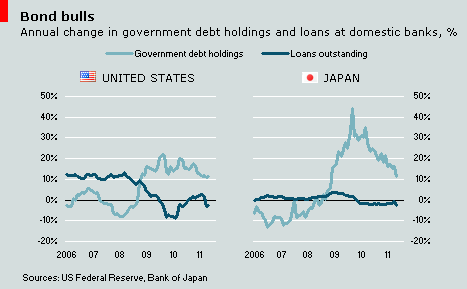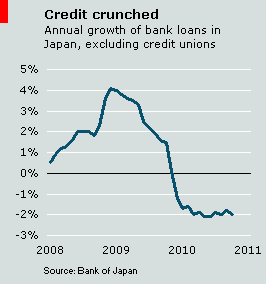You are currently browsing the tag archive for the ‘lending’ tag.
After a brief growth spurt, bank lending in the US shrank in April and May, according to the latest data from the Federal Reserve. As Bloomberg points out, banks’ appetite for government bonds has remained relatively robust since the onset of the financial crisis. American banks now hold almost US$1.7trn in treasuries and related government debt, with holdings growing by an 11-12% annual clip so far this year, despite miserly yields.
The situation at Japanese banks looks eerily similar. Funds are being recycled into government bonds instead of loans, with year-on-year credit in a seemingly permanent state of contraction. The Economist Intelligence Unit does not expect America to experience a protracted slump like the one that has dogged Japan since its spectacular asset-price bubble burst in early 1990s. Still, there are enough similarities in some metrics to cause discomfort.
Encouragingly, deposits at American and Japanese banks are at or near record highs. This will please regulators, who are urging banks to avoid flightier wholesale sources of funding. But until these funds are put to more productive use than stockpiling low-yielding government bonds, nobody will be truly happy.

In most large countries, loan growth of 17% would represent a breakneck pace. In China, such growth is perceived as sign of a slowdown.

In May, the value of China’s outstanding bank loans rose by 17% from the year before, the slowest pace since late 2008. A series of interest rate increases and, more importantly, hikes to banks’ reserve requirements appear to be cooling the stimulus-fuelled surge in lending recorded in the months after the global financial crisis. The latest boost to reserve requirements, announced today, is the sixth hike so far this year. More increases are likely in the coming months, as worries persist over rising consumer inflation—5.5% in May—and a frothy property market. Still, the Economist Intelligence Unit expects China’s GDP to grow by 9% this year, only a modest slowdown from the 10.3% growth recorded in 2010. Despite the central bank’s tightening measures, credit conditions will remain relatively loose.
(Note: Some data in this post, and the accompanying chart, have been updated to reflect revised historical data.)
As Bernanke and company gather in Washington today and tomorrow to assess the strength of the US economy, there is some encouraging news from the country’s banks. Business lending grew at almost an 8% annualised clip in December, according to recent data. This, however, is unlikely to affect the Fed’s policy stance, with no change expected to the US$600bn asset-purchase programme or near-zero policy rates.
What’s more, the month-on-month annualised jump in business loans in December doesn’t tell the entire story. Year on year, the stock of commercial and industrial lending fell for the twentieth consecutive month in December. The ratio of banks’ cash to business loans, although down from recent all-time highs, remains elevated in historical terms.
Recent data on lending, spending and—later this week—overall economic growth in the fourth quarter will give some comfort to American policymakers. However, the recovery has much longer to run. A Fed rate hike is unlikely before the second half of 2012.

Sberbank, by far Russia’s largest bank, reported quarterly earnings today. Its net profit in the first nine months of the year, Rb109.6bn (US$3.5bn), is more than ten times the total in the previous year. A steep fall in provisions helped, as did a rise in fee and commission-based income.

Russia faces many daunting challenges as it recovers from a severe recession. But one important thing it has going for it—and a crucial advantage in relation to other large economies—is that it will not suffer from the need to deleverage huge volumes of private debt. Since the start of the year, Sberbank has grown its loan portfolio by nearly 8%, with similar rises recorded for both corporate and consumer loans. Net interest income, however, is 4% down on the previous year, thanks to falling interest rates and “competition for good borrowers”, the bank said. Struggling to serve rising demand from borrowers is nonetheless a challenge that many other banks would welcome.
Your correspondent spoke at a corporate finance conference in Nicosia today, where much of the talk was about Tuesday’s downgrade of Cyprus by Standard & Poor’s. The ratings agency cited Cypriot banks’ exposure to souring Greek debt as an important factor in its decision. The country’s large banking sector—assets are worth nearly 700% of GDP—came in for criticism by corporate executives at the event, but not necessarily for the prominence the banks received in S&P’s statement.

Stubbornly high interest rates on bank loans are irking corporate borrowers; they pay similar rates today as in early 2008, despite the steep fall in benchmark euro area interest rates over this period. Bankers argue that this is because their funding costs are much higher than elsewhere in the euro area, as they compete for deposits with liquidity-hungry Greek banks and a sprawling co-operative sector that offers high rates for political, rather than economic, reasons. What’s more, one banker said, many of the loan applications he sees are related to restructuring instead of growth, and taking on “other banks’ problems” doesn’t appeal. With heavy exposure to Greece’s teetering economy, Cypriot banks have plenty of scope for problem-solving within their existing loan portfolios for some time to come.
 “The recovery seems to be pausing”. In its latest monthly economic report, Japan’s central bank strikes a sombre tone. The latest data from the country’s banks, published a day later, will offer little encouragement.
“The recovery seems to be pausing”. In its latest monthly economic report, Japan’s central bank strikes a sombre tone. The latest data from the country’s banks, published a day later, will offer little encouragement.
Following a 2% year-on-year decline in October, the outstanding loan balance of Japan’s commercial banks has now fallen for 11 consecutive months. It’s somewhat curious, then, that the central bank also reports that “firms see financial institutions’ lending attitudes as improving”.
A series of big, bold charts accompanies the latest report on consumer debt in the US by the New York Fed (via Alea, also discussed here). The report contains plenty of interesting data about the ongoing deleveraging of American households. As of the end of September, total indebtedness is down by 7.4% from its peak value two years earlier. The distaste for new debt is underscored by trends in mortgage originations, which are running at 50% of their 2003-07 average, and credit cards, which have seen a net 120m accounts—one hundred and twenty million—closed since mid-2008.

The majority of data and analysis at Financial Services Briefing is available only to subscribers. Each week, a small share of content from the service is made available to non-subscribers.

Although each passing quarter puts more space between Mexico’s banks and the severe recession of 2008-09, the country’s largest lenders remain hesitant. Even compared with last year, the toughest operating environment for banks in more than a decade, third-quarter earnings at the top five financial groups—which control about three quarters of all banking assets—were distinctly ambivalent.
While most of the banks reported year-on-year earnings growth in the third quarter, this was generally due to a decline in loan-loss provisions, as non-performing loan ratios steadily return to their historically average levels. In terms of core business, Mexico’s low interest rates continue to put pressure on net interest income nearly across the board.
But while earnings did little to impress, the third quarter nonetheless suggested a possible inflection point in credit growth.
Read more at Financial Services Briefing: “Cautiously optimistic” (November 2nd)
 Taiwan’s financial regulator recently released new data on the country’s local banks, noting that asset quality was “getting better unceasingly” (which probably sounds more elegant in the original Mandarin). The island’s 37 domestically-owned banks control more than 90% of the local lending business, and despite faster loan growth this year the ratio of non-performing loans has fallen steadily. In fact, at 0.78% in September, the ratio of sour loans to assets now stands at an all-time low, an achievement few other banking systems can match these days.
Taiwan’s financial regulator recently released new data on the country’s local banks, noting that asset quality was “getting better unceasingly” (which probably sounds more elegant in the original Mandarin). The island’s 37 domestically-owned banks control more than 90% of the local lending business, and despite faster loan growth this year the ratio of non-performing loans has fallen steadily. In fact, at 0.78% in September, the ratio of sour loans to assets now stands at an all-time low, an achievement few other banking systems can match these days.
 The data is noisy and, at times, somewhat contradictory. Yesterday, banks’ use of the European Central Bank’s 0.25% deposit facility fell to its lowest level of the year, with “only” €28.5bn parked at the central bank. This can be seen as a sign of renewed confidence among euro zone financial firms, particularly when it comes to interbank lending—banks may be deciding to lend more to one another, instead of stashing cash at the ECB.
The data is noisy and, at times, somewhat contradictory. Yesterday, banks’ use of the European Central Bank’s 0.25% deposit facility fell to its lowest level of the year, with “only” €28.5bn parked at the central bank. This can be seen as a sign of renewed confidence among euro zone financial firms, particularly when it comes to interbank lending—banks may be deciding to lend more to one another, instead of stashing cash at the ECB.
However, on the same day, use of the ECB’s 1.75% marginal lending facility hit a two-week high. The previous high, in late September, proved to be a one-off spike. Sustained borrowing at the current level—last seen during the spring, when fears of a sovereign debt crisis reached a crescendo—would suggest that it is still difficult for some European banks to attract private funds. This warrants watching.

